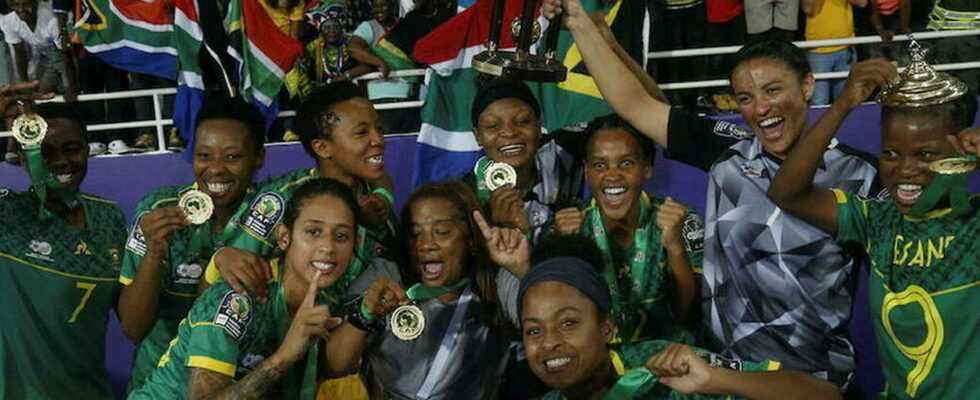L’2022 edition of the Women’s African Cup of Nations ended on the evening of Saturday July 23 with the historic victory of the Banyana Banyana (1-2) in Rabat, against a Moroccan team that will not have been unworthy. Far from it, a fanatic country of the round ball, Morocco has taken a passion for women’s football and has trained behind it, thanks to a precise organization of the event, an entire continent.
READ ALSO Lions against Swallows: all the nicknames of CAN teams
South Africa champion after many attempts
Thanks to the achievements of Hildah Magaia (63e and 71e), South Africa got the better of Morocco, who, despite Rosella Ayane’s reduced score (80e) and nine minutes of additional time, could not find the resources to hang an extension. After five lost finals (a record in the competition), the Banyana Banyana of Desiree Ellis, at the head of the selection since 2016 and named for the third time best coach of the continent this week at the CAF Awards, managed to win their first African Cup of Nations against the host country.
The first continental title after two COSAFA Cups won in 2017 and 2018. With an impeccable course, and winning six games out of six, South Africa, along with the other teams in the last four (Morocco, Zambia and Nigeria), validated his ticket for the 2023 World Cup. Senegal, eliminated by Zambia in the quarter-finals, and Cameroon, eliminated by Nigeria, both winners of their repechage match, will play an intercontinental qualifying tournament for the World Cup.For South Africa, this victory is very significant in this year of the inauguration of the Champions League having crowned the Mamelodi Sundowns, a club dear to CAF President Patrice Motsepe, and which provided five players for the South African selection. African.
READ ALSOAfrica joins the Women’s Football Champions League
Nigeria trapped
Winner of the last three editions of the CAN, Nigeria is to women’s football what Real Madrid can be in the Champions League. With eleven final victories in fourteen editions before 2022, the dominance of the Super Eagles demonstrates the lead that the country has long had over the rest of the continent, although the demographic factor can be considered a major asset for a discipline that gradually democratized. Reason why his elimination in the semi-finals of the competition against the Moroccan host country was a real earthquake.
Reduced to ten and then nine against eleven, the Super Falcons delivered a heroic effort to manage to go until penalties, before finally bowing. Defeated by Zambia, present at the Tokyo Olympics in the match counting for third place, Nigerian domination is no longer uncontested as it was the case in the past. We can believe that there is a rebalancing between the different nations that are starting to pay more attention to women’s football, although Nigeria remains undoubtedly the major footballing nation in Africa.
READ ALSOCAN 2018 women: Nigeria on the roof of African football
A founding CAN for Morocco?
Despite a defeat in the final, which remains the best performance in its history, this CAN allowed Morocco (77e nation in the Fifa ranking), coached by former French international Reynald Pedros, to breathe new life into women’s football and take a fresh look. In order to advance this discipline, a development program had been set up by the federation, including a budget of 6 million euros. At the heart of its policy: to professionalize the championship so as to reach the figure of 90,000 professional players and 10,000 coaches by 2024. Efforts which visibly pay off, especially since Morocco has also placed a club, the FAR Rabat (with eight players present selected), in the final of the first edition of the Champions League.
In addition, Morocco has demonstrated, like men’s football, that it is capable of hosting major international competitions, whether in terms of the quality of infrastructure or the enthusiasm aroused in particular for matches of the host team of Morocco. The semi-final between the Atlas Lionesses and Nigeria, played in front of 45,562 spectators, was a record attendance for the competition, a record which was undoubtedly beaten for the final, with a Moulay-Abdallah stadium in Rabat full several hours before kick-off.
READ ALSOWomen’s World Cup: unprecedented performance of Africa
A success for CAF
Regarding the Confederation, satisfaction is in order: never has a women’s CAN interested the public so much. This enthusiasm resulted in an explosion in the audience, with a broadcast of the final on more than thirty African channels, not to mention the major broadcasters from Europe and the Middle East. To the great satisfaction of CAF Secretary General Veron Mosengo-Omba: “For the first time, CAF has invested heavily in the TV product of this women’s CAN. This has led to more behind-the-scenes content for our media rights partners, directly resulting in improved coverage. We are committed to raising the standards and quality of the TV product. A commitment in line with the ambitions of the new presidency of CAF. Indeed, as a prelude to the competition, President Patrice Motsepe had announced a 150% increase in the share, the total amount going from 975,000 dollars to 2.4 million dollars. The winner’s prize money has increased from $200,000 to $500,000, the finalist receives $300,000 against $175,000 previously, that of the semi-finalist is set at $225,000 (against $125,000). As the number of teams increased from eight to twelve, the quarter-finalists received $175,000. A great success that announces great challenges to maintain the wave on which women’s football is surfing in Africa.
READ ALSO2019 Women’s World Cup: Africans in orbit
